Speech The Australian Economy in 2007

Malcolm Edey
Assistant Governor (Economic)
Address to the Australian Industry Group, Economy 2007
Sydney –
Once again I thank AI Group for the invitation to come and speak at this event.
Some years ago, the RBA took the decision to build up its business liaison program as a supplement to our regular analysis of economic data. To that end, we set up a dedicated liaison team in head office, and also established regional offices in the other mainland capitals. We take this work very seriously, and our staff are now talking to an average of about 100 contacts a month around the country. AI Group has been an important participant in that work, and we very much appreciate the co-operation they have given us since the start of the program.
I want to talk today about some aspects of Australia's current economic situation.
The longer-term context
I'll begin with a few remarks about the longer-term context. The Australian economy was last in recession in 1991, so the current period of expansion is now in its sixteenth year (Graph 1).
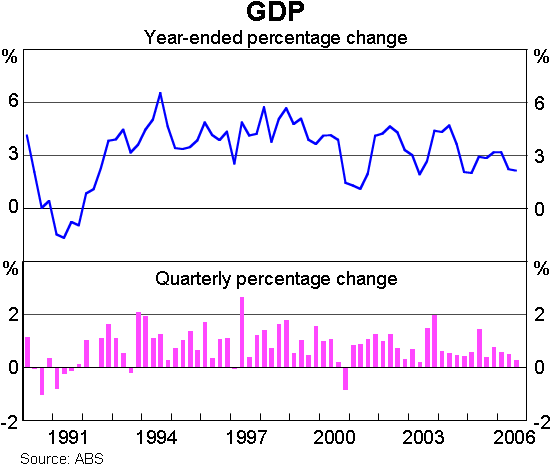
The overall performance in that period has clearly been good, both by the standards of our own earlier history and in comparison with other advanced countries.
A few observations will help to make that claim a bit more concrete:
- Australia's growth rate since 1990 has averaged 3¼ per cent. That compares favourably against most (though not all) of the advanced OECD countries that we would normally take as a benchmark. One important aspect of that result is that, unlike a number of the other advanced countries, Australia avoided recession in 2001 (Table 1).
| GDP | GDP per capita | |
|---|---|---|
| Ireland | 6.4 | 5.3 |
| Australia | 3.3 | 2.1 |
| United States | 3.0 | 1.9 |
| Norway | 3.0 | 2.6 |
| New Zealand | 3.0 | 1.8 |
| Spain | 2.9 | 2.5 |
| Canada | 2.8 | 1.7 |
| United Kingdom | 2.5 | 2.1 |
| Netherlands | 2.3 | 1.6 |
| Sweden | 2.2 | 1.8 |
| France | 1.8 | 1.4 |
| Germany | 1.7 | 1.3 |
| Italy | 1.3 | 1.1 |
| Japan | 1.3 | 1.1 |
|
Sources: ABS; CEIC; Consensus; IMF; Thomson Financial |
||
- Australia's inflation performance has also been good. Since the inflation target was first formulated in 1993, CPI inflation in Australia has averaged 2½ per cent – in the middle of the target zone.
- It is also noteworthy that both growth and inflation have become more stable over time. One way to summarise that is to look at the standard deviations of these variables over successive decades. Economic performance deteriorated markedly in the 1970s, but volatility has been reduced in each decade since then. In the current decade, the outcomes for GDP growth, and for inflation, have been only about half as variable as they were in the 1980s (Table 2).
| 1970s | 1980s | 1990s | 2000s | |
|---|---|---|---|---|
| Output | 1.5 | 1.0 | 0.8 | 0.5 |
| Inflation^ | 1.3 | 0.8 | 0.5 | 0.3 |
|
* Standard deviations of quarterly percentage changes ^ CPI inflation excluding interest charges prior to the September quarter 1998 and adjusted for the tax changes of 1999–2000 |
||||
I have a couple of brief comments to make on the consequences of this period of stable growth. The first is that economic slack has been substantially wound back. Unemployment has come down to a 30-year low, and direct measures of business capacity usage, such as this one from the NAB survey, are close to cyclical highs (Graph 2).
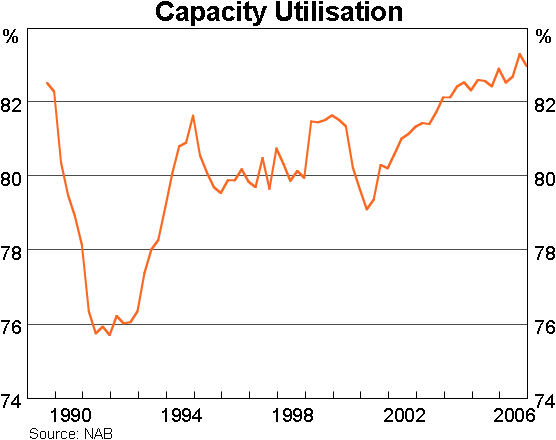
This means that the problems facing businesses and economic managers are very different from those of a few years ago. For example, businesses are commonly reporting that labour shortages are the main constraint on their activities, whereas previously they would have cited concerns about lack of sales or orders. It also means, as the RBA has been pointing out for some time now, that we should not expect the economy to grow as quickly as it did a few years ago, when there was still a lot of surplus labour and capital to be re-employed. These points, by the way, should not be seen as negatives. Rather, they are a consequence of economic success as the economy moves back closer to full employment.
My second comment concerns regional differences. In any given year, it is not uncommon to see significant differences in growth rates across the States, and the current period is no exception to that. At the moment, it is well known that the south-eastern states are growing more slowly than the resource-rich states of Western Australia and Queensland. At other stages of the cycle the positions have been reversed. Nonetheless, all the States have benefited from the extended nature of the current expansion. A useful summary indicator of that is the movement in unemployment rates (Graph 3).
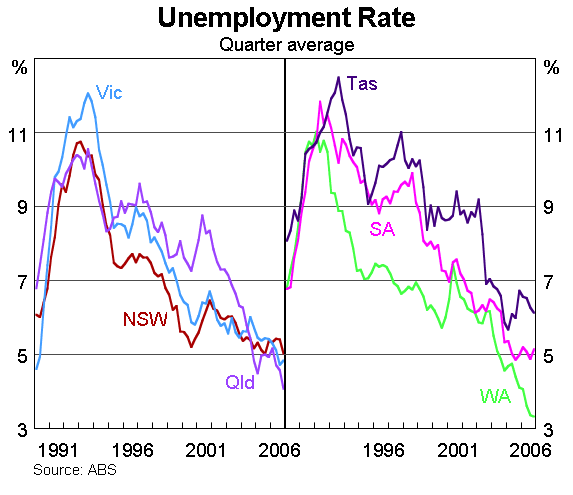
Clearly, on this measure, Western Australia and Queensland are performing the most strongly at the moment. But viewed over a longer period, all the States have seen their unemployment rates decline to their lowest for many years.
So the economy now is at an advanced stage in an expansion marked by reasonably stable growth, low inflation and falling unemployment. What are the prospects that this period of stable growth will continue? That will depend on many factors, not least of which is the evolution of the global economy, which I'll turn to now.
Short-term global outlook
For the world economy as a whole, 2006 was another strong year. Growth for the year is estimated at 5¼ per cent, which is the highest rate in more than three decades. Consensus forecasts for the next two years are a bit below that figure, but still well above average. Of course, the two-year-ahead forecast is highly conjectural, but the forecast for 2007 is probably a reasonable indicator of the current momentum (Graph 4).
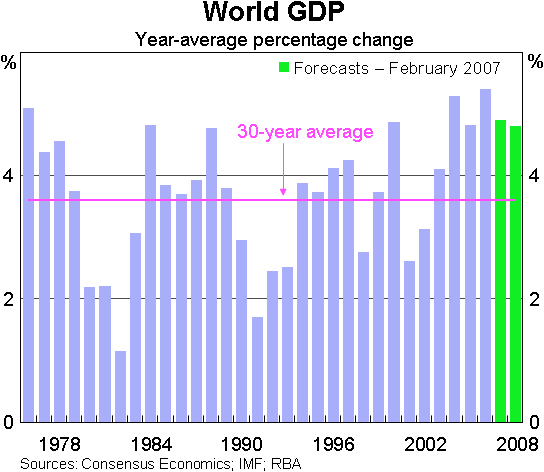
In thinking about short-term prospects, a good deal of attention in the past few months has been focused on the United States. The US economy has been growing strongly for some years, and most expectations now are that it will slow back to a more sustainable pace. This is generally seen as a desirable adjustment, and one that should help to alleviate inflationary pressures in the US. The issue at the moment is whether the downturn in the US housing sector might have a larger than expected impact on the wider economy. Forward indicators of construction activity, like starts and permits, are down by about 30 per cent from their cyclical peaks, and the market for established houses has also cooled (Graph 5).
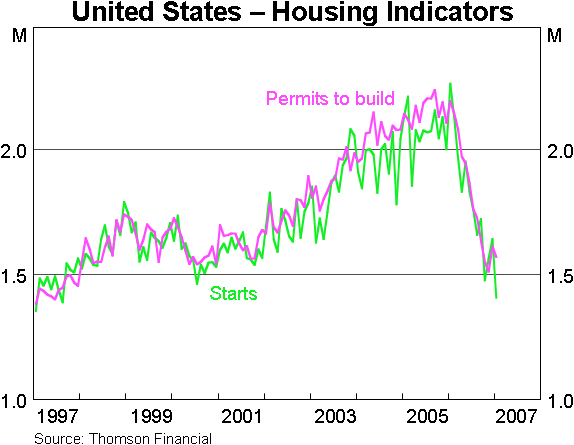
How far these things might continue is still unclear, and recent indicators have been ambiguous. But at this stage, the overall slowing in the US economy has been very mild, and the housing downturn so far has not caused any major disruption to the rest of the economy.
In other parts of the world the recent flow of new information has tended to be on the strong side of expectations. In Japan, GDP posted a surprisingly strong increase of 1.2 per cent in the December quarter, and other short-term indicators like employment and business sentiment point to continued momentum (Graph 6).
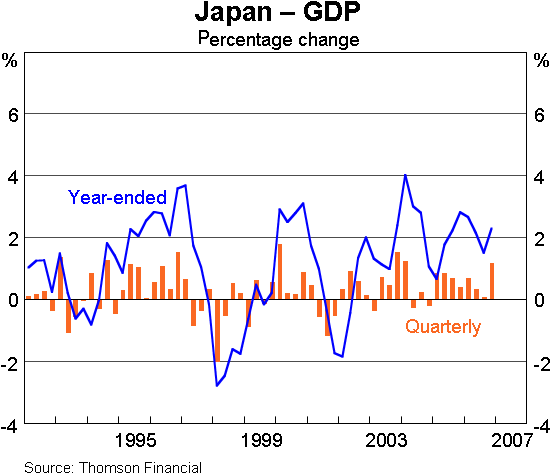
It is also encouraging that the longer-term problems of balance-sheet stress in Japan have been wound back, and there are signs of a return to more normal financial conditions. Profits are now rising rapidly, corporate debt has been reduced, and banks are again starting to expand their lending. Another sign of return to normality is that land prices in some areas, notably in Tokyo, have stopped falling. These things, while obviously not guaranteeing economic success, do bode well for further growth over the years ahead.
China's economy is continuing to grow at a 10 per-cent-plus pace. I note that there has been some significant volatility in China's financial markets in the past week or so, but it is too early to say whether that is likely to be disruptive to the economy's immediate prospects. But I will have more to say about China in a moment.
The other encouraging development for the world economy has been a pick-up in growth in the euro area (Graph 7).
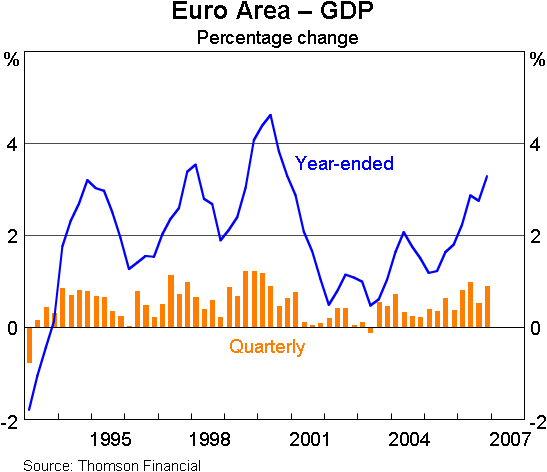
Europe was slow to recover from the downturn at the beginning of the decade, and for some years lagged behind the US. It was commonly said that the world economy was flying on only two of its four engines. But with the euro area now growing at 3.3 per cent for the latest year – slightly faster than the US – and Japan also doing better, that claim is no longer true. Overall, then, the growth in the world economy looks to be more evenly balanced, geographically, than it has been for quite a while, and the prospects for global growth in the short-term seem to be good.
Longer term, of course, it is to be expected that the world economy will continue to have a cycle, and I see little value in trying to predict when the next turning point might be. It may be more useful to think about some of the longer-term forces that might be expected to operate beyond the length of the business cycle. Probably the most important of these is the emergence of China and India as major economies.
The rise of China and India
On almost any measure, the Chinese and Indian economies have advanced rapidly in their importance both to the world economy and to Australia (Table 3).
| China | India | |||
|---|---|---|---|---|
| 1995 | 2005 | 1995 | 2005 | |
| Share of world GDP (PPP weights) | 9.5 | 15.4 | 4.8 | 6.0 |
| Share of world GDP (mkt weights) | 2.5 | 5.0 | 1.2 | 1.7 |
| Share of world trade | 2.3 | 6.1 | 0.5 | 0.9 |
| Share of Australian exports | 4.4 | 11.6 | 1.5 | 5.0 |
|
Sources: ABS; CEIC; IMF |
||||
A few summary figures can illustrate this. Their combined share of world trade has more than doubled in the past ten years, from just under 3 per cent to around 7 per cent. Their importance as export markets for Australia has gone up even more, so that together they now absorb about one-sixth of Australia's total exports. They are also increasing their share of world GDP very significantly, though not as quickly as their share of world trade.
The obvious question that arises from these observations is how long these trends might continue. One way of thinking about this is to remember that the extraordinary growth in China and India is essentially a process of catch-up (Graph 8).
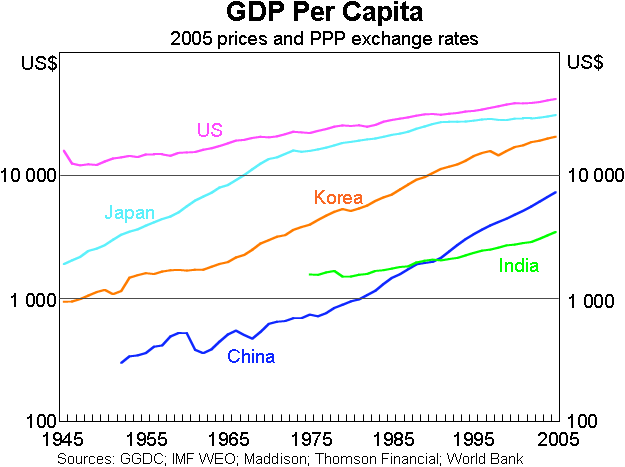
Countries are able to achieve rapid growth at certain stages of development essentially by catching up to the productivity levels of the most advanced countries, approximated here by the US. Two good examples of this in an earlier period are Japan and South Korea. Both of those countries experienced extended periods of rapid growth and then began to slow down as they got closer to the frontier.
So how long might China's exceptionally high growth rates be sustained? A crude look at the history of Japan and Korea in the post-war period might suggest a reasonable expectation of 3 decades of growth in the vicinity of 10 per cent per annum. But that may well understate the potential of China and India. China took off from a much lower base than either Japan or Korea so that today, even after 3 decades of rapid growth, it is still well behind the relative income levels of Korea and Japan when they started to slow down. And India is a lot further behind still. On that basis, there is at least the potential for this process of catch-up growth in the two most heavily populated countries to continue for decades to come.
One very obvious set of effects flowing from all this is on the demand for resources. Clearly the Chinese and Indian economies are going to be increasingly important buyers of raw materials. To take the example of China, we can see that this is already happening for a range of resource commodities (Graph 9).
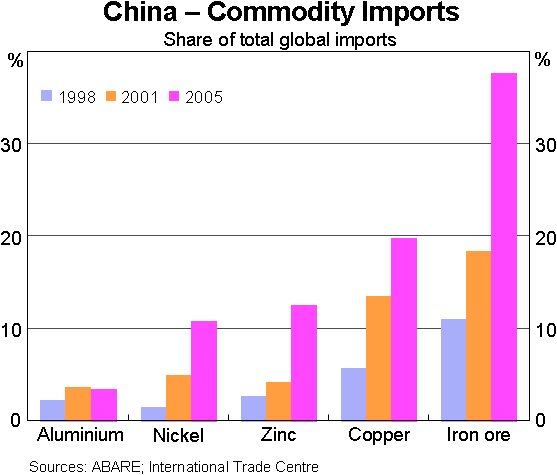
The extreme example is iron ore, where Chinese demand has increased from 11 per cent to 37 per cent of global imports in less than a decade. Some of that, no doubt, will have replaced demand from other countries, but a big part represents a net increase in global resources demand. So China is already a large presence in world commodities demand, and it has the potential to become much larger, as does India in its turn.
This of course has some significant implications for Australia. Compared with other countries, Australia's trade is weighted towards exports of minerals and imports of manufactured goods. So Australia's terms of trade will be essentially driven by the global forces affecting the prices of resource commodities relative to those of traded industrial outputs. For a long time, most analysis suggested that this relative price was on a downward trend, but the recent experience has gone sharply the other way.
From a global perspective, this process can be thought of as an increase in the supply of unskilled labour – that is, the release over a period of time of large numbers of unskilled workers into the industrial sectors of previously underdeveloped economies. For the world as a whole, this kind of shock can be expected to have some significant effects on relative prices, at least during the period of transition when the additional labour is being absorbed. Other things equal, it reduces the prices of labour intensive industrial outputs relative to the price of scarce inputs, notably raw materials. This seems to have been what happened in the last few years, although it is difficult to disentangle these structural forces from other more temporary influences that might have contributed to it.
At the same time, we should recognise that there are other forces that could limit the relative price shift over time. Economic convergence should eventually mean rising real wages and rising output prices in today's low-cost producers. In addition we should recognise that the extent of the real increase in resource prices will ultimately depend on the supply response of resource producers. What we can say with confidence is that the world is experiencing a very large increase in resources demand which is likely to go on for some time.
Australia has been among the beneficiaries of the shift in global relative prices that has taken place over the past few years (Table 4).
| Selected G-20 countries | |
|---|---|
| Russia | 48 |
| Australia | 32 |
| Indonesia | 17 |
| Mexico | 12 |
| Canada | 9 |
| South Africa | 5 |
| Argentina | 5 |
| United Kingdom | 0 |
| France | −1 |
| Turkey | −3 |
| Germany | −6 |
| Italy | −6 |
| United States | −7 |
| Korea | −19 |
| Japan | −23 |
|
Sources: ABS; CEIC; IMF; Thomson Financial |
|
In fact, if we rank the countries in the G-20 grouping according to the movements in their terms of trade over the past three years, Australia has had one of the biggest increases. More generally, the gainers have been the net resource exporters like Russia, Canada and Australia. There has been a broadly neutral impact on countries with roughly balanced commodities trade, while the losers have been the net resource importers such as Japan.
A rough gauge of the effect on Australia over this period is the contribution it has made to the growth of real national income. Real GDP growth over the past three years has averaged 2.9 per cent, while gross domestic income (which takes into account the terms of trade effect) has grown at an average rate of 4.8 per cent, or nearly 2 percentage points faster. This boost to real incomes has been one of the reasons that measures of real domestic expenditure have been able to grow persistently faster than output in recent years.
Challenges for the manufacturing sector
So the aggregate effects of rising resource prices on the Australian economy have been to add to growth in incomes, living standards and expenditure. But the effects are obviously not uniform. The flip side of this shift in world relative prices has been a decline in relative prices of traded manufactured goods. In a forum where manufacturers are heavily represented, I am conscious that this presents some difficult challenges, and I want to focus the last part of my talk on that area.
The long-run trend in manufacturing is that it has grown more slowly than the rest of the economy, and hence the industry's share of GDP has been falling (Graph 10).
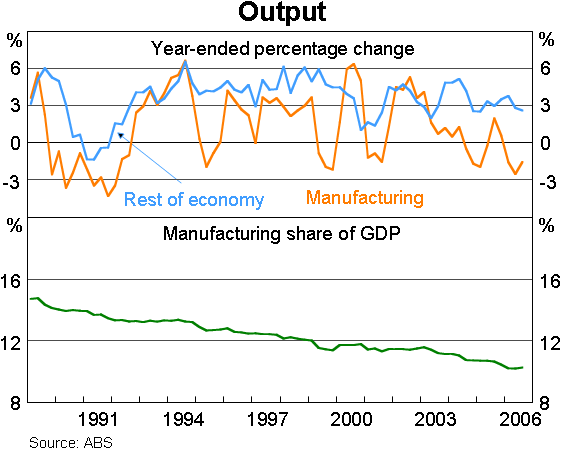
This is not an uncommon situation for an advanced economy where the share of services has been correspondingly rising. Superimposed on that trend have been some more recent factors that accelerated the decline, though some of these should be temporary in nature. They include the rapid growth in Chinese imports, a maturing of the domestic construction cycle and the effect of the drought on food exports. In recent years these factors have more than offset the boost to production from a movement into higher-skilled manufacturing industries, like pharmaceuticals and electronics.
We can usefully analyse these developments by classifying sub-industries within manufacturing as being domestically-focused, import-competing or export-oriented (Graph 11).
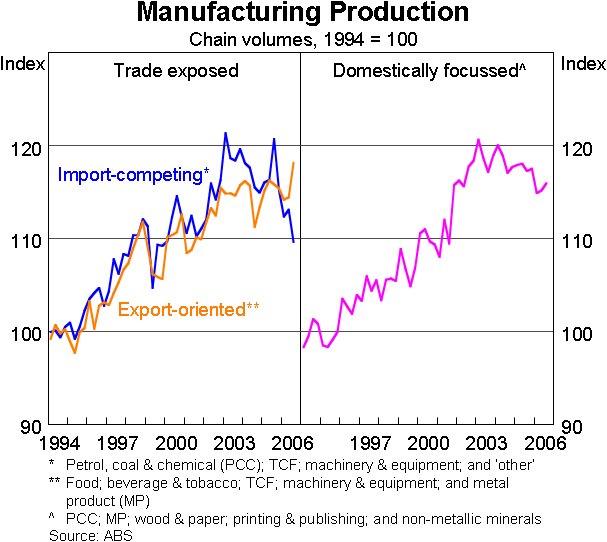
All three broad sectors recorded modest growth during the 1990s. But more recently the trends have diverged.
Activity in the domestically focused sector has come off its peak from around three years ago, after some very strong increases in the couple of years prior to that. Mostly this seems to reflect developments in housing construction, and so should prove cyclical in nature. In the latest year, there has been some pick-up in construction-related manufacturing, driven by the strength in the non-residential sector.
Production in the import-competing sector has fallen much more significantly in this period, reflecting a sharp increase in import penetration (Graph 12).
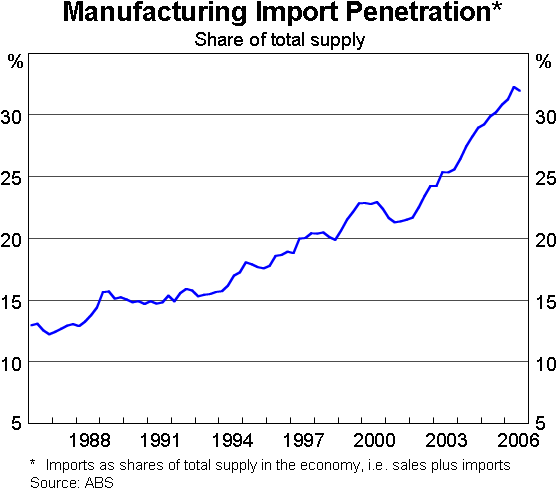
These trends have been especially evident in the textile, clothing & footwear industry, where local producers have faced tough competition from Chinese producers with markedly lower cost structures.
On a more positive note, export-oriented businesses have fared better in recent years, with manufactured exports recording continued growth (Graph 13). Exports of what we classify here as ETMs have increased at an average rate of 4 per cent over the past three years. Even though the overall growth rate has slowed down since the previous decade, there have been some encouraging successes in high value-added areas like pharmaceuticals, professional & scientific equipment and industrial machinery.
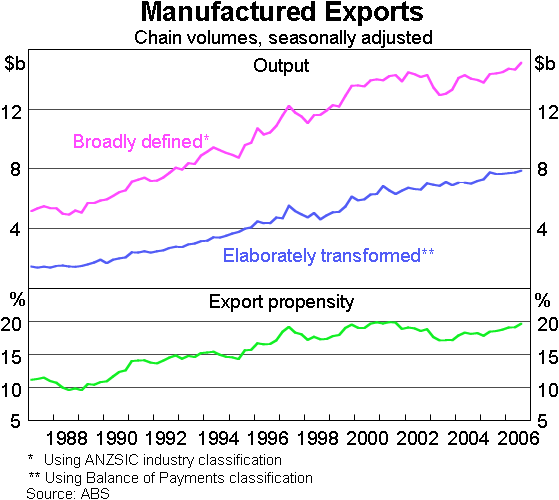
Let me finish by summing up the main points.
The Australian economy has had a lengthy period of expansion. By past standards, we have had reasonably stable growth and low inflation, and the economy has moved closer to full capacity.
The short-term outlook for the world economy looks like it will be favourable to further growth in Australia.
Longer term forces driven by the emergence of China and India are having some significant effects on Australia's direction of trade, and on relative prices. This has given a significant boost to aggregate incomes and spending. At the same time, it has posed some challenges for manufacturers, although export-oriented manufacturers have managed to continue to grow their businesses in recent years.
Thank you, and I wish you the best of success in 2007.